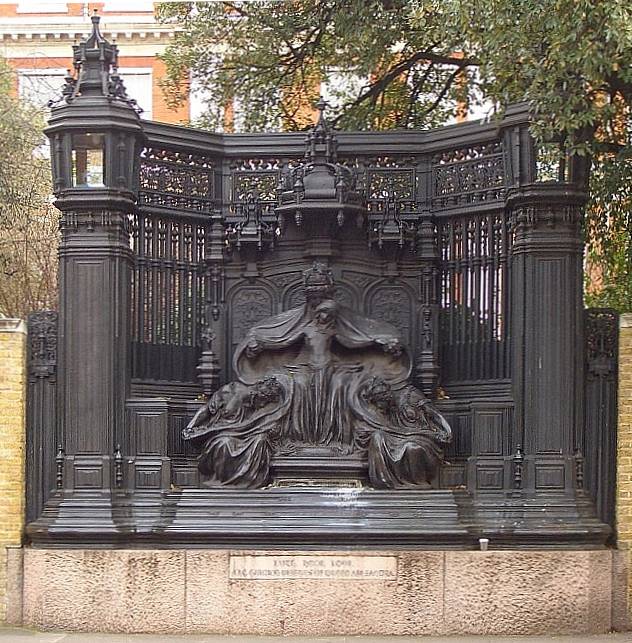
The Queen Alexandra Monument by Sir Alfred Gilbert, R. A. (1854-1934). 1926-1932. Bronze on red granite plinth. Marlborough Gate, London. [Entire monument] On the plinth is written: "Faith, Hope, Love / The Guiding Virtues of Queen Alexandra." Photograph 2009” by Jacqueline Banerjee. [This image may be used without prior permission for any scholarly or educational purpose.]
Commentary from Robert Bowman's Sir Alfred Gilbert and the New Sculpture (2008). Mr. Bowman and the Fine Art Society, London, have most generously given their permission to use information, images, and text from this exhibition catalogue in the Victorian Web. Copyright on text and images from their catalogues remains, of course, with them. [GPL]Commentary
Faith, hope, and love — a more accurate translation of the scriptural text than the often-heard "faith, hope, and charity" — are the virtues here attributed to the late queen, but at first glance it is not clear what relation they have to the three crowned figures, one of whom supports a young girl, who would seem to represent the human soul. The two central figures appear with closed eyes (asleep or in a trance?), and the other two, who are clearly asleep, reveal Gilbert's affinity with the Symbolist movement but also make the meaning of the work unnecessarily enigmatic.
Fortunately we have Richard Dorment, who convincingly explains the work's multi-layered symbolism, pointing out in the process that the memorial to Queen Alexandra "sums up themes which he had explored and returned to again and again during a lifetime's work." Gilbert's initial conception took the following form:
Central group — represents. 'Love Enthroned', supported” by Faith and Hope, on either side, and Love is directing a Boy setting out across the 'River of Life', which springs from beneath Her Throne — symbolizing Queen Alexandra's charity to children, also the water typifies Her advent to Great Britain from across the water.
The last phrase reminds us that Alfred had been among the little boys at Gravesend cheering the Princess when she arrived in England in 1861 and that she had always proved a loyal friend to him — pleading his cause to King Edward, sending him money in exile, and eventually intervening to insure his safety in Bruges. Therefore when the committee approached him, he was ready with a scheme to commemorate a woman towards whom he had every reason to feel gratitude. [317]
In the first model, the central figure was a naked toddler, which the sculptor next changed to a boy "about ten or eleven years old" (318) and finally to a clothed young girl approaching womanhood. Dorment reminds us that Gilbert had previously employed the theological virtues in other memorials, but
what is new here is the gestures of these Virtues; the three crowned women bow and minister to the young girl, and the central figure, Charity [i.e., Love], draws out the child's limp arms to form a cross. This alludes to a completely different visual tradition: not to representations of the Theological Virtues, but to those of the three women who either attend the prostrate Virgin Mary at the foot of the cross, or mourn over the body of the dead Christ at the Crucifixion. . . .” by referring to the Lamentation, he introduced the theme of mourning without resorting to illustration. The Christian dimension of the memorial is further reinforced” by the allegorical figure of Religion displaying a cross on the left-hand finial of the throne.
Now we come to the girl whom he positions between the legs of the figure of Charity. In Renaissance painting the placement of an infant or adult between its parent's knees symbolizes parturition and therefore descent from the preceding generation: the placement of the child in the Alexandra Memorial implies that she is born from a Trinity of Faith, Hope and Charity and that the Queen, who possessed all these virtues, had passed them on to a younger generation of women. [321-22]
According to Dorment, the Alexandra Memorial provides a summation of the artist's ideas. It also forced a reluctant King, who heartily disliked the sculptor, both to confer a knighthood upon him and make the Royal Academy readmit him. The memorial, in other words, had enormous significance to Gilbert as a man and an artist. But the apparent sleep of the two crowned virtues renders the meaning — and the achievement — of the memorial far less clear than it might have been. — George P. Landow
Other views
Bibliography
Bowman, Robert. Sir Alfred Gilbert and the New Sculpture. London: The Fine Art Society, 2008.
Dorment, Richard. Alfred Gilbert. New Haven: Yale University Press, 1985.
Last modified 3 March 2009